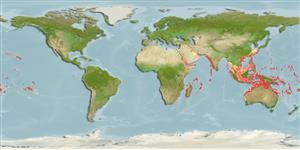Common names from other countries
>
Eupercaria/misc (Various families in series Eupercaria) >
Labridae (Wrasses) > Bodianinae
Etymology: Bodianus: Bodianus after Bodiano or Pudiano, from the Portuguese pudor, meaning modesty (Jordan & Evermann, 1896).; axillaris: Name from the Latin noun axilla for arm pit, apparently referring to the prominent black spot in the axilla of the pectoral fin (Ref. 75973).
More on author: Bennett.
Environment: milieu / climate zone / depth range / distribution range
Ekologi
laut berasosiasi dengan karang; kisaran kedalaman 2 - 100 m (Ref. 9823), usually 2 - 40 m (Ref. 27115). Tropical; 24°C - 27°C (Ref. 27115); 32°N - 32°S
Indo-Pacific: Red Sea to South Africa (Ref. 35918), east to the Marshall, Marquesan and Tuamoto islands, north to Japan (Ref. 559).
Size / Weight / umur
Maturity: Lm ? range ? - ? cm
Max length : 20.0 cm SL jantan/; (Ref. 9823)
Duri punggung (Keseluruhan (total)) : 12; duri punggung lunak (Keseluruhan (total)) : 9 - 10; Duri dubur: 3; Sirip dubur lunak: 12 - 13. Juveniles and females easily recognized by the generally black body with large white spots; males have large black spots on the soft parts of the dorsal and anal fins (Ref. 48636). Juveniles resemble the juveniles of B. mesothorax but have white rather than yellow spots. Undergoes a dramatic color change with growth.
Adults inhabit clear lagoon and seaward reefs (Ref. 1602); common in clear shallow waters at 1-8 m; large individuals occasionally at greater depths below 27 m (Ref. 75973). Juveniles occur solitary in caves or under ledges and act as cleaners by picking at bodies of other fishes (adults occasionally do this) (Ref. 1602); occurring regularly at depths of 14-26 m (Ref. 75973). Feed mainly on benthic, hard-shelled, invertebrates such as mollusks and crustaceans (Ref. 9823). Oviparous, distinct pairing during breeding (Ref. 205). Not commonly marketed. Occasionally seen in the aquarium trade.
Life cycle and mating behavior
Maturities | Reproduksi, perkembang biakan | Spawnings | Egg(s) | Fecundities | Larva
Oviparous, distinct pairing during breeding (Ref. 205).
Westneat, M.W., 2001. Labridae. Wrasses, hogfishes, razorfishes, corises, tuskfishes. p. 3381-3467. In K.E. Carpenter and V. Niem (eds.) FAO species identification guide for fishery purposes. The living marine resources of the Western Central Pacific. Vol. 6. Bony fishes part 4 (Labridae to Latimeriidae), estuarine crocodiles. FAO, Rome. (Ref. 9823)
Status IUCN Red List (Ref. 130435)
CITES (Ref. 128078)
Not Evaluated
ancaman kepada manusia
Harmless
penggunaan manusia
Perikanan: nilai komersial kecil; Akuarium: Komersial; umpan: occasionally
Alat, peralatan
laporan khas
muat turun XML
Sumber internet
Estimates based on models
Preferred temperature (Ref.
115969): 24.4 - 28.9, mean 27.5 (based on 1326 cells).
Phylogenetic diversity index (Ref.
82804): PD
50 = 0.5000 [Uniqueness, from 0.5 = low to 2.0 = high].
Bayesian length-weight: a=0.01202 (0.00551 - 0.02625), b=3.05 (2.87 - 3.23), in cm Total Length, based on LWR estimates for this Genus-body shape (Ref.
93245).
Trophic level (Ref.
69278): 3.4 ±0.45 se; based on food items.
Daya lenting (Ref.
120179): sedang, Waktu penggandaan populasi minimum 1.4 - 4.4 tahun (Preliminary K or Fecundity.).
Fishing Vulnerability (Ref.
59153): Low vulnerability (14 of 100).
